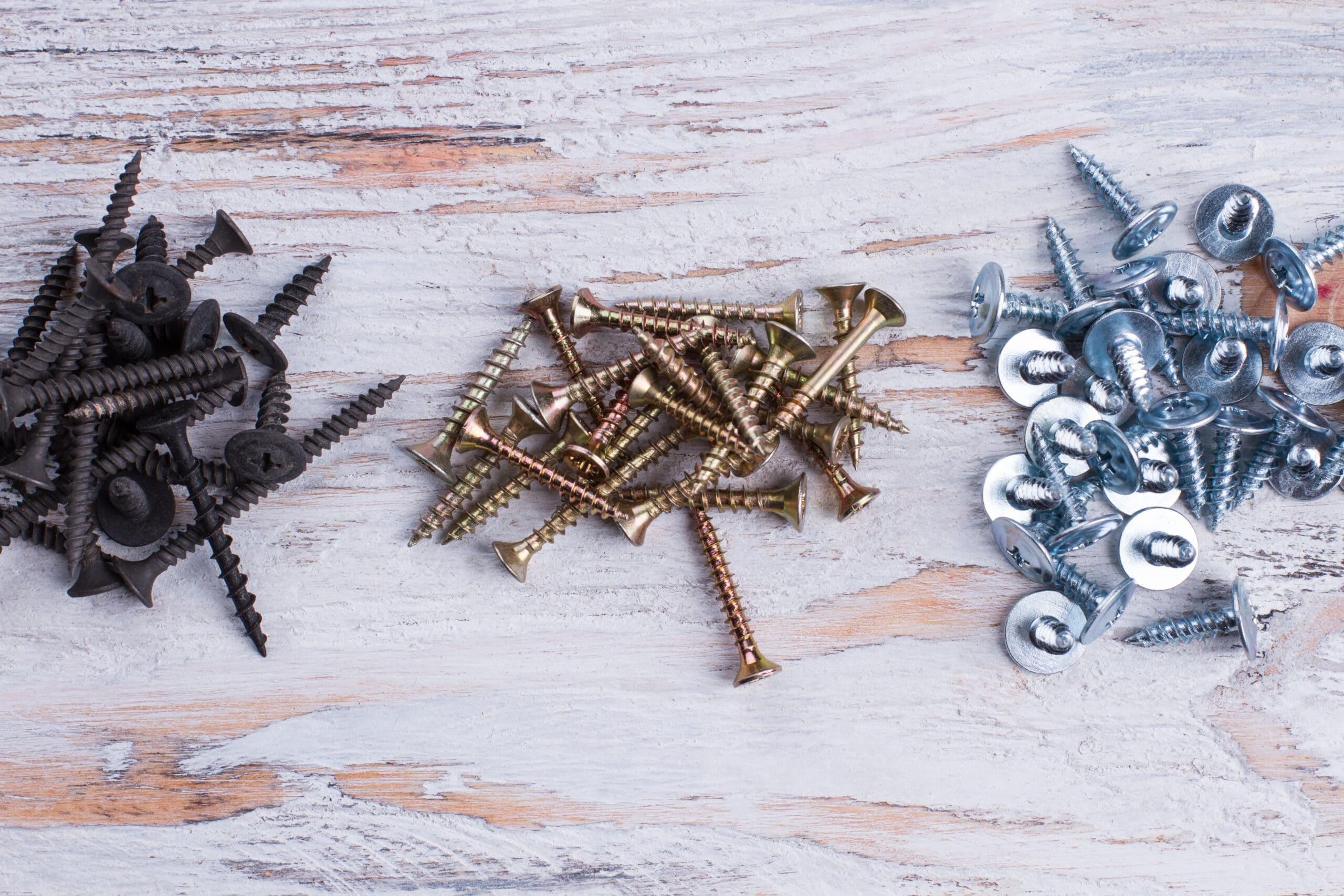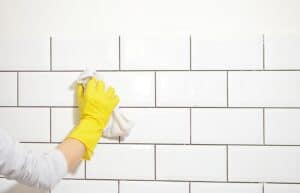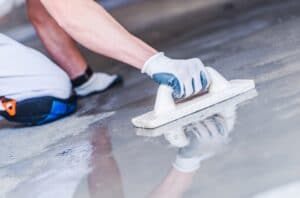The 10 Types of Screws you should know about.

Screws are everywhere. They hold much of our world together, and even the most inexperienced DIYer has definitely used a screw or two before.
Simple, right? Well, not quite. There are plenty of different types of screws out there, and you really shouldn’t be using just any old screw for your project. Chances are there’s actually a specific screw out there for the job that you’re doing.
There’s not even a solid agreement on exactly how many types of screws there are. A quick Google search will return everything from 9 to 12 to 36 – but we reckon there are roughly 10 you should know about. Here they are:
1. Wood Screws
Used for drilling into wood, this is your standard screw. It’s commonly made of bronze, brass or steel and comes in lots of different sizes. There’s not a lot to be said about this one – you know it, you love it. But it’s a good time to get familiar with the different parts of a screw.
Wood screws have threading most of the way up the shank, and the threading gets coarser towards the sharp tip of the screw. The threading stops just before the head, which can be flat, round or oval and is commonly tapered into the shank. You should pre-drill a hole for these screws.
2. Chipboard Screws
Chipboard screws are similar to your standard wood screw, but they have skinnier shanks and a coarser thread. This thread is usually asymmetrical, a feature that distinguishes it from a standard wood screw and gives it extra holding power in the chipboard
Another difference is that these threads run all the way from the tip to the head of the screw, whilst standard screws have some unthreaded shank at each end. Combined with the other features, this is a screw that’s been specifically designed to grip well in a soft, composite material like chipboard
Overall, these aren’t exactly heavy-duty screws. But that’s perfect for chipboard, which can be easily damaged by other, larger screws.
3. Plasterboard/Drywall Screws
As the name suggests, these screws are perfect for fastening things to drywall and plasterboard. They have deeper threads than a regular screw, which helps them stay firmly lodged in the plasterboard. Their tips are also sharper to reduce tearing.
These screws are generally black, as they’re often coated in a protective layer like carbon or zinc to prevent corrosion over time. All of this makes them a great choice for fastening things to your plaster walls, like installing brackets or hanging a painting.
One last thing – you’ll find these screws in two types. W-type drywall screws are for fastening drywall to timber. They’re longer, thinner and have a coarser thread. S-type screws are designed for attaching metal. S-types have a sharper tip and a finer thread. They are usually self-drilling (which means you won’t need to pre-drill a hole).
4. Metal Fixing Screws (Sheet Metal Screws)
These are a type of ‘self-tapping’ screw (more on this later) that are designed for fastening metal to metal or metal to timber. You’ll commonly see these with hex heads, although as with most of the screws on this list, there are all kinds of heads available including Phillips and flatheads.
These screws have threads all the way up the shank, and these threads are much sharper than your average screw. The tip is extra-sharp too, as these screws need to cut through solid metal and hold firmly. You might use these to attach sheet metal to a frame or to build metal furniture.
You can generally drill these screws straight into softer materials, but you’ll need to drill a smaller pilot hole first in tougher metals like steel. That’s because these are ‘self-tapping’ screws – which is a bit different from a self-drilling screw. In fact, let’s get into the differences between these two now.
5. Self Tapping Screws
This is a broad category of screws that other more specific screws – like the sheet metal screws above – may fall into. A self-tapping screw has threading that is designed to tap itself into the material it’s being screwed into.
Usually made out of hardened steel or other solid materials, the thread on this screw is sharp and goes all the way down to the tip. This helps the screw cut into the material and thread (or ‘tap’) itself into the material as it goes in. This gives you a quick, easy screw-in and an extra-strong bond.
On softer materials, a self-tapping screw can be drilled right in. However, you’ll still need to drill a pilot hole first for tough materials, because the tip won’t be sharp enough to get through. This hole should be slightly smaller in diameter than the screw so that the threading on the shank can still ‘tap’ in.
The terms self-tapping screw and self-drilling screw are often used interchangeably, but there are some differences between the two. I’ll explain what they are below.
6. Self-Drilling Screws or ‘Tek’ Screws
A self-drilling screw is similar to a tapping screw but it has a tip that resembles a drill bit, so it drills its own hole as it goes in. Behind this is a thread that, like in a self-tapping screw, is designed to ‘tap’ itself into the surface for a stronger bond.
So what makes this different from a self-tapping screw? The crucial difference is the drill-bit shaped tip; a self-drilling screw is drilling itself a hole before the rest of the screw goes in. A self-tapping screw is only threading itself in, or ‘tapping’, and it will generally require you to drill a pilot hole first. The self-drilling screw eliminates this extra step.
Self-drilling screws are often called ‘Tek’ screws after a popular brand of screws that have become synonymous with this design. Some people consider these the most convenient screws to use, and it’s true that they can save you a lot of time when applied to the right project.
7. Masonry & Concrete Screws
As the name suggests, these are heavy-duty screws that are good for fastening timber, metal and plastic to concrete and masonry. They’re often made out of carbon or other tough, corrosion-resistant materials.
They have hardened, notched threads that alternate between high and low. This helps cut into the hard concrete and adds grip, but more importantly, this clever design also removes concrete shavings effectively and helps to stop deformation in the concrete.
The tips of these screws are sharp, but not so sharp that you won’t need a pilot hole first. Like with self-tapping screws, this pilot hole should be smaller in diameter than the screw to allow the thread to tap in.
If you try to punch one of these into concrete or masonwork without a pilot hole, you probably won’t get far. Our pro-tip? Use an impact driver for this screw instead of a regular drill – here’s why.
8. Roofing Screws
Roofing screws are heavy-duty screws that are built to last, and they’re perfect for – you guessed it – attaching roofing. There are a lot of different roofing options out there, so you’ll find a wide variety of roofing screws designed for different materials, from metal to timber to colorbond.
However, there are generally a few uniting features that make all of these screws a roofing screw. For one, a roofing screw has much better washers than other screws, usually made of neoprene rubber that’s designed to make a watertight seal. After all, the last thing you want is a leaky roof!
For this reason, many roofing screws are also self-drilling, to minimise the chance of creating a less-than-watertight hole in your roof. And because roofing screws are exposed to the elements, they’re generally made of very sturdy materials. It’s also common that they’re galvanised or zinc-plated to further prevent the risk of corrosion.
9. Treated Timber Screws
Treated pine and other pressure-treated timbers are a highly popular material for DIY-ers, especially when you’re building furniture or installing decking. But it’s important to always use treated timber screws when you’re working with this material.
This is because the chemicals used to preserve or ‘treat’ this wood oxidises with zinc, and this will quickly corrode and destroy most standard materials. To resist this chemical reaction, treated timber screws need to be made of stainless steel, hot-dipped galvanised steel, or feature a ceramic coating.
If it’s not made, there’s a good chance that the copper and other chemicals in treated pine will eat it away. Don’t cheap out and use standard screws with treated pine or other pressure-treated timber – you’ll pay the price!
10. Batten Screws
Batten screws are heavy-duty screws, and they’re great for securing heavy timber. They’re great for securing hardwood to a sub-floor, or for other heavy-load construction tasks.
The defining feature of a batten screw is the shape of the head, which is called a ‘bugle’ head. These bugle heads feature a less severe angle, allowing the screw to countersink neatly into the hard timber without splitting the wood. The tip of the screw is extra-long and specially fluted to catch any wood chips.
These screws also feature a very thick shank – usually around 7mm – and come in a range of lengths, although you can expect them to be fairly long. Self-tapping threads or self-drilling tips are common amongst batten screws as well, though not always present.
Finally, these screws generally have hex-bit heads – don’t ask us why. However, you can sometimes find them with flat-head or Phillips-head grooves instead.
So there you have it. Understanding these 10 popular types of screws will make it much easier to select the right screw for your next DIY project or professional job. There’s still plenty to talk about when it comes to the humble screw, so we’ll be posting more blogs about it in the near future.
Multifors is an online hardware store that’s focused on quality and convenience. Check out our huge range of screws, power tools and accessories here. Next-day delivery across Metro Melbourne from $19.95.
-
 11, Jul, 2022
11, Jul, 2022Feature Product: The Stain Proof Range
We regularly review some of our favourite products. Today, we’re... -
 5, Jul, 2022
5, Jul, 2022Concrete Sealer: What You Need to Know
Concrete is a sturdy material that’s practical and affordable. In... -
 24, Jun, 2022
24, Jun, 2022A Product Guide for DIY Pool Areas
Tiling a pool area is a great DIY project. In...


